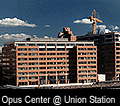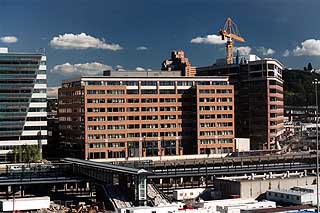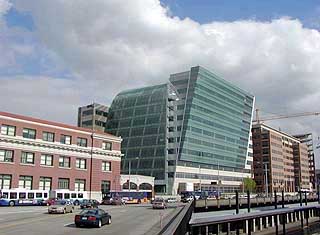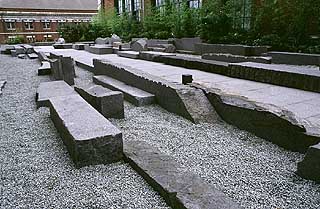
DJC.COM
Union Station
November 9, 2000
From coal plant to depot to office complex
Journal Staff Reporter
Erupting on the southern edge of downtown, the $250 million Union Station office complex -- a 7.5-acre island of steel, glass, concrete and brick wedged between Fourth and Fifth avenues -- has quickly remade its surroundings, stretching downtown south to the stadium complex and bridging the gap which once stood between the International District and Pioneer Square.

|

|
In only a couple of years, the former train depot gained a 1,100-stall underground parking garage and five new buildings with more than 900,000 square feet of office and retail space. A sixth new building situated north of Jackson Street will add another 105,000 square feet of rentable space to the complex.
The speed with which the area has changed belies the years of planning and failed attempts that preceded development of the site.
Developer Nitze-Stagen & Co. acquired the land from Union Pacific Railroad in 1995. UP had put it up for sale in 1989. Alan Cornell, vice president at Nitze-Stagen, once worked for Union Pacific. He described the site, most of which was 22 feet below street level, as mostly "a big hole in the ground."
Project history
Certainly, nothing about the site's history pointed toward its new white-collar incarnation. From 1874 until the early 1900s, a coal gasification plant operated on the land. Then, in 1907, Union Pacific began building the Union Station depot on the corner of Fourth Avenue South and South Jackson Street, and operated its railroad out of there until 1971, when the station closed.
Union Pacific Realty, the railroad's real estate arm, took over the property in 1984 after it was clear that the railroad had no further plans to operate there. After studying the site, the realty group decided to develop an office park.
With a plan in hand, Union Pacific embarked on the review and permitting process, and received its master use permit in 1989. Yet by that time, said Cornell, the market was overbuilt, and Union Pacific decided to get out of the real estate development business, and put the property up for sale.
Over the next four years, a number of developers took an interest in the property, but nothing materialized. Koll Development planned to begin building on the site as early as 1990 before backing away. Quadrant Corp. and Birtcher Real Estate had also looked at the property. Starbucks and Aldus (now Adobe) considered the site for office complexes, and Microsoft co-founder Paul Allen's development group optioned the site for what was to become the Experience Music Project, before landing a space at Seattle Center.
Ultimately, Nitze-Stagen won the rights to the property in 1995 over three other developers that submitted proposals to the state of Washington.
After Nitze-Stagen formed a partnership called Union Station Associates with Paul Allen's Vulcan Northwest in 1997, the site was finally purchased from Union Pacific for $11.2 million.
Developing the site
Despite the years that ellapsed since Union Pacific's master plan for the site in the mid-1980s, the plan remained unchanged when Nitze-Stagen began development. When the Seneca Group stepped in to manage Vulcan's development of 505 Union Station in 1998, "the (Property Use and Development Agreement) showed the basic building design negotiated in 1988," said Lindy Gaylord, a principal of Seneca.
"The whole master plan was a collaboration," said Cornell, who when he was with Union Pacific had worked with review boards for both Pioneer Square and the International District to create buildings designed to fit into the neighborhoods. Building heights were restricted to 150 feet, and development plans were to include shorter buildings and pedestrian space as well.
Nitze-Stagen's approach to the development was to divide up the site and sell the pads separately. Initial work on the site included infrustructure improvements such as building the 1,100-stall parking garage as well as an eight-story, 700-stall garage just south of the development, on the south side of Airport Way.
In addition, the Union Station depot was fully renovated for $22 million, the price for which it was sold to Sound Transit. Though the renovation of Union Station was seen as an important gesture to attract developers, "We would love to have that as a spec building now," mused Cornell.
One unusual facet of the complex is that construction of the underground garage required that support columns for future buildings above had to be placed before the above-ground structures were even designed.
Before development began, however, Nitze-Stagen had to work out a consent decree with the state Department of Ecology to address contamination concerns. The coal gasification plant that had existed on the site left behind coal-tar waste that posed a potential threat to ground water. Though no remediation work has been necessary, the developer has spent $750,000 on legal costs and other associated fees.

|
Yet when asked to point to the biggest risk Nitze-Stagen took on the project, Cornell named construction of a substantial amount of infrastructure, including the underground parking garage and elevators. Original plans for the development assumed that the projects would be constructed in phases over a period of 12 years. A risk was that seismic and building codes could change before the property was sold off for development.
In any case, once Vulcan Northwest was on board, "the pads went quickly," said Cornell.
Vulcan Northwest secured a pad for its headquarters in 1998, paying the partnership over $8 million for the 505 Union Station site. Vulcan purchased an additional pad that became a public plaza.
Minnesota-based developer Opus Northwest came forward shortly thereafter and bought three more pads. A final pad was sold to Seattle developer Martin Selig in May after its previous owner, San Francisco developer Pat Mahoney, filed for bankruptcy.
Once Opus's final building is completed next spring, only Selig's pad will remain undeveloped.
Jon Silver can be reached at (206) 622-8272 or by e-mail at jsilver@djc.com.
Jon Silver can be reached by email or by phone at (206) 622-8272.
Other Stories:
Copyright ©2009 Seattle Daily Journal and DJC.COM.
Comments? Questions? Contact us.